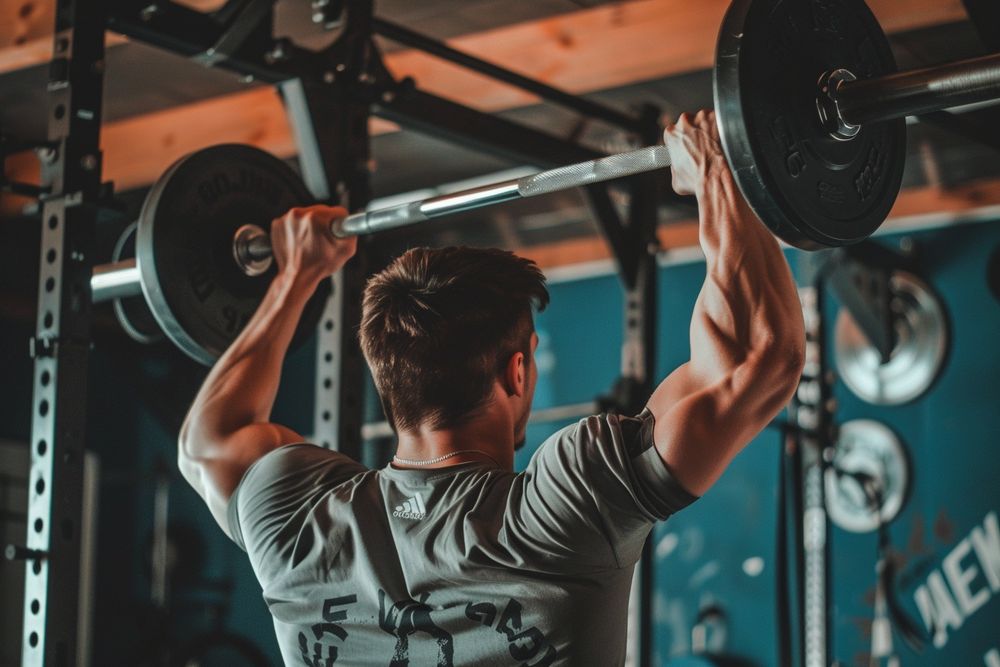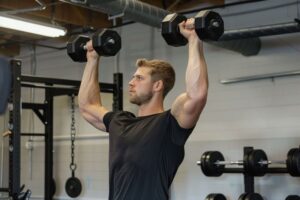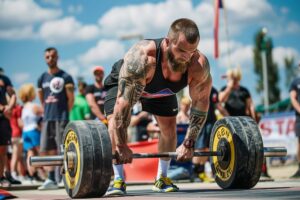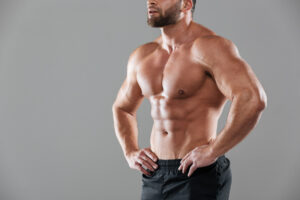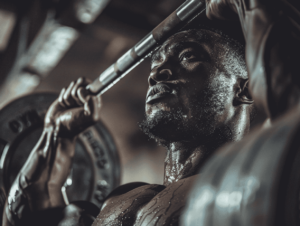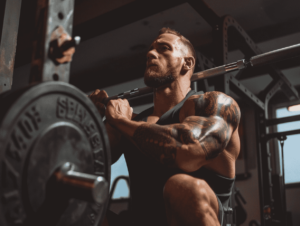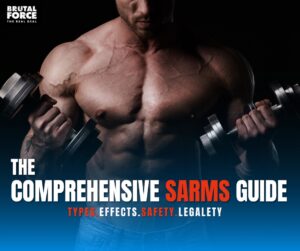The overhead press is a cornerstone of strength training, revered for its ability to build formidable upper body strength. This powerful movement targets multiple muscle groups simultaneously, making it an efficient and effective exercise for athletes and fitness enthusiasts alike.
Whether you’re a seasoned lifter or just starting your fitness journey, mastering the overhead press can significantly enhance your overall strength and physique. Let’s dive into the world of overhead pressing and unlock its potential to transform your upper body.
This article is brought to you by Brutal Force – your ultimate source for safe, legal alternatives to steroids and SARMs. With scientifically-backed formulas designed to enhance muscle growth, strength, and performance, Brutal Force helps you achieve your bodybuilding goals without the harmful side effects. Discover a range of products that cater to your bulking, cutting, and overall fitness needs. Experience transformative results with Brutal Force today.
What is the Overhead Press?
The overhead press, also known as the shoulder press, is a compound exercise that involves lifting a weight from shoulder level to an overhead position. This pressing movement primarily engages the shoulders, triceps, and upper chest muscles.
While it may seem straightforward, the overhead press requires proper technique and coordination to execute safely and effectively. By mastering this movement, you’ll develop not only strength but also stability and control in your upper body.
Benefits of Mastering the Overhead Press
Incorporating overhead presses into your workout routine offers a multitude of benefits. First and foremost, it’s an excellent way to build shoulder strength and muscle mass, contributing to that coveted V-tapered physique.
Beyond aesthetics, the overhead press enhances functional strength that translates to everyday activities. Think about how often you lift objects overhead in daily life – from putting away groceries to reaching for items on high shelves.
Moreover, as a compound exercise, the overhead press engages multiple muscle groups simultaneously, making it a time-efficient choice for those looking to maximize their workout results. It’s truly a powerhouse movement that deserves a place in every strength training program.
Types of Overhead Presses
The world of overhead pressing is diverse, offering various techniques to suit different fitness levels and goals. Each type of overhead press brings its own unique benefits and challenges to the table.
Let’s explore the main variations you’re likely to encounter in your strength training journey. Understanding these different types will allow you to choose the best option for your specific needs and preferences.
Standing Overhead Press
The standing overhead press is often considered the gold standard of pressing movements. Performed from a standing position, this variation engages not only your upper body but also your core and legs for stability.
One of the key benefits of the standing overhead press is its ability to improve overall body coordination and balance. As you press the weight overhead, your entire body works to maintain stability, resulting in a full-body workout.
This variation also closely mimics real-life movements, making it an excellent choice for developing functional strength. Whether you’re an athlete looking to improve performance or someone aiming to enhance daily activities, the standing overhead press is a valuable addition to your routine.
Seated Overhead Press
The seated overhead press offers a more stable base, making it an excellent option for beginners or those recovering from lower body injuries. By performing the press while seated, you eliminate the need for leg and core stabilization, allowing for a more isolated upper body workout.
This variation is particularly useful when you want to focus solely on upper body strength without the added challenge of full-body stabilization. It’s also a great choice when you’re looking to lift heavier weights with less risk of lower back strain.
However, keep in mind that the seated position does reduce some of the functional and core-strengthening benefits of the standing variation. It’s often best used as a complementary exercise to standing presses rather than a complete replacement.
Push Press
The push press is a dynamic variation of the overhead press that incorporates leg drive to help press the weight overhead. This explosive movement begins with a slight dip of the knees, followed by a powerful leg extension that helps drive the weight up.
By utilizing leg power, the push press allows you to handle heavier weights than a strict overhead press. This makes it an excellent choice for building overall power and strength, particularly for athletes in sports requiring explosive upper body movements.
Equipment for Overhead Pressing
When it comes to overhead pressing, you have several equipment options at your disposal. Each type of equipment offers unique benefits and challenges, allowing you to tailor your workout to your specific goals and preferences.
Let’s explore the most common tools used for overhead presses and how they can enhance your training. Remember, variety in your equipment choices can help prevent boredom and promote well-rounded strength development.
Lastly, don’t feel pressured to use all types of equipment – find what works best for you and your fitness journey.
Barbell Overhead Press
The barbell overhead press is a classic choice for building raw strength and power. Using a barbell allows you to lift heavier weights compared to other equipment options, making it ideal for those focused on maximizing strength gains.
One of the key advantages of the barbell overhead press is its ability to engage both arms equally, promoting balanced muscle development. This symmetrical loading also helps in developing overall stability and control.
When performing the standing barbell press, you’ll find it challenges your core stability more than other variations. This added challenge can lead to improved overall body strength and coordination, making it a favorite among serious strength athletes.
Dumbbell Overhead Press
Dumbbell exercises offer unique benefits for overhead pressing, particularly in terms of muscle activation and range of motion. Unlike barbells, dumbbells allow for a more natural movement pattern, which can be gentler on your shoulder joints.
One of the main advantages of using dumbbells is the increased stability requirement. Each arm works independently, which can help identify and correct strength imbalances between your left and right sides.
Dumbbells overhead also allow for a greater range of motion at the bottom of the movement. This increased ROM can lead to better muscle development and improved shoulder flexibility over time.
Kettlebell Overhead Press
Kettlebell presses offer a unique challenge due to their off-center weight distribution. This design forces your stabilizing muscles to work harder, potentially leading to greater overall shoulder strength and stability.
One arm kettlebell presses are particularly effective for developing unilateral strength and identifying any imbalances between your left and right sides. They also require a high degree of core engagement to maintain proper form throughout the movement.
Proper Form and Technique
Mastering proper form is crucial for maximizing the benefits of the overhead press while minimizing the risk of injury. Good technique not only ensures you’re targeting the right muscles but also allows you to lift heavier weights safely over time.
Let’s break down the key components of proper overhead press form. Remember, it’s always better to start with lighter weights and perfect your technique before progressing to heavier loads.
Starting Position
The foundation of a successful overhead press lies in a solid starting position. Begin by standing with your feet about shoulder-width apart, creating a stable base for the lift.
Grip the bar slightly wider than shoulder-width, allowing for a comfortable and natural pressing motion. The bar should rest on your upper chest, with your elbows pointing forward and slightly down.
Engage your core muscles and maintain a neutral spine throughout the movement. This engagement will help protect your lower back and provide a stable platform for pressing.
The Press Movement
As you press the bar overhead, focus on moving it in a straight line. The bar path should be as vertical as possible, passing close to your face as you press upward.
Initiate the movement by squeezing your shoulder blades together and pressing the bar straight up. As the bar clears your head, slightly lean back and push your head forward, allowing the bar to travel in a straight line.
Keep your core engaged throughout the movement to maintain stability. Avoid arching your lower back or using momentum to drive the weight up – the power should come from your shoulders and arms.
As you approach the top of the movement, focus on fully extending your arms without locking out your elbows. This helps maintain tension in the muscles and reduces stress on the elbow joints.
Lockout and Descent
At the top of the movement, your arms should be fully extended with the bar directly over your shoulders. Ensure your body forms a straight line from your ankles to your wrists.
To lower the weight, begin by slightly bending your elbows and controlling the descent of the bar. Maintain the same vertical bar path as you lower the weight back to your upper chest.
Remember to maintain proper form throughout the entire range of motion, including the descent. Controlling the weight on the way down is just as important as pressing it up.
Common Mistakes and How to Avoid Them
Even experienced lifters can fall prey to form errors in the overhead press. Recognizing and correcting these mistakes is crucial for maximizing your gains and preventing potential injuries.
Let’s explore some of the most common pitfalls in overhead pressing and how to address them. By being mindful of these issues, you can ensure your overhead press technique stays on point.
Remember, it’s always better to lift lighter weights with proper form than to sacrifice technique for heavier loads. Prioritize quality over quantity in your overhead pressing journey.
If you’re unsure about your form, consider working with a qualified fitness professional who can provide personalized guidance and feedback.
Overarching the Back
One of the most common errors in the overhead press is excessive arching of the lower back. This often occurs when lifters try to press weights that are too heavy for their current strength level.
To maintain a neutral spine position, focus on engaging your core muscles throughout the entire movement. Imagine pulling your ribcage down and your pelvis slightly forward to create a strong, stable midsection.
Incorrect Bar Path
Proper bar path is crucial for an efficient and effective overhead press. The ideal path is as close to a straight vertical line as possible, passing near your face as you press overhead.
To achieve this, focus on moving your head back slightly as the bar passes your face, then forward again as you complete the press. This allows the bar to travel in a straight line without hitting your chin or nose.
Muscles Worked in the Overhead Press
The overhead press is a compound exercise that engages multiple muscle groups simultaneously. Understanding which muscles are worked can help you appreciate the exercise’s full-body benefits and inform your overall training program.
Let’s break down the primary and secondary muscle groups targeted during overhead pressing. This knowledge will help you better understand how the overhead press fits into your broader strength training goals.
Remember, while certain muscles are emphasized more than others, the overhead press is truly a full-body movement that requires coordination and engagement from head to toe.
Primary Muscle Groups
The overhead press primarily targets the deltoids, which are the round muscles that cap your shoulders. All three heads of the deltoid (anterior, medial, and posterior) are engaged during the press, with the anterior deltoid taking on the most work.
In addition to the shoulders, the overhead press heavily recruits the upper chest muscles, particularly the clavicular head of the pectoralis major. This engagement contributes to overall upper body development and can help create that sought-after chest definition.
Secondary and Stabilizing Muscles
While not the primary movers, several other muscle groups play crucial roles in the overhead press. The rotator cuff muscles, for instance, work to stabilize the shoulder joint throughout the movement.
The upper back muscles, including the trapezius and rhomboids, are also engaged to support the shoulder blades and maintain proper posture during the press. These muscles help create a stable platform from which to press.
Progressing in the Overhead Press
Improving your overhead press performance requires a strategic approach to training. Whether your goal is to lift heavier weights or perform more repetitions, progression is key to continuous improvement.
Let’s explore some effective strategies for advancing your overhead press. Remember, progress takes time and consistency, so be patient with yourself and trust the process.
Always prioritize proper form over weight increases. It’s better to make slow, steady progress than to rush and risk injury or develop poor habits.
Progressive Overload
Progressive overload is the cornerstone of strength training progress. This principle involves gradually increasing the demands on your muscles over time, typically by adding more weight to your lifts.
When it comes to the overhead press, aim to increase the weight you’re lifting by small increments – even as little as 2.5 pounds can make a difference. Remember, progress isn’t always linear, so don’t be discouraged by occasional plateaus.
Varying Rep Ranges
Incorporating different rep ranges into your overhead press training can help stimulate muscle growth and strength gains. Try alternating between heavy sets (3-5 reps) for strength, moderate sets (6-12 reps) for hypertrophy, and lighter sets (15+ reps) for endurance.
Don’t be afraid to occasionally work with lighter weights to focus on perfecting your form or to give your joints a break from heavy lifting. This variety can help prevent burnout and keep your training interesting.
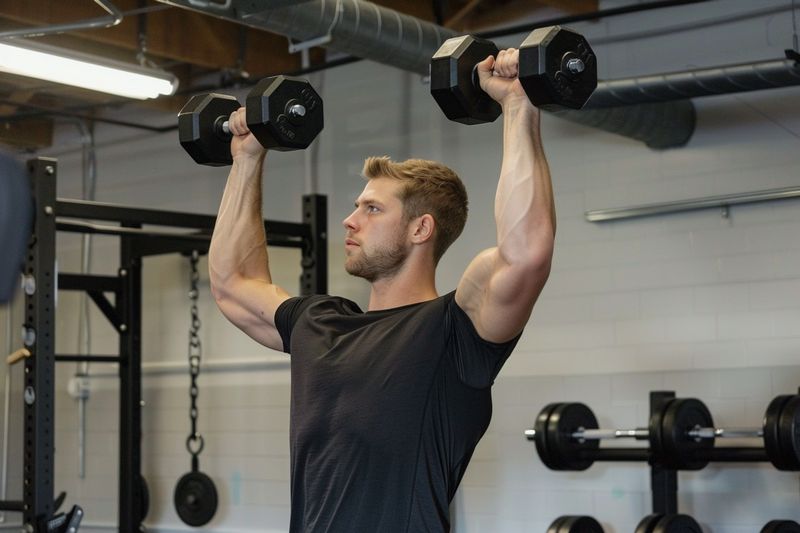
Overhead Press Variations
While the standard overhead press is a powerful exercise in its own right, incorporating variations can add diversity to your training and target your muscles in slightly different ways. These variations can help break through plateaus and keep your workouts engaging.
Let’s explore some popular overhead press variations that you can add to your routine. Remember, it’s not necessary to use all these variations – choose the ones that align best with your goals and preferences.
Behind-the-Neck Press
The behind-the-neck press is an advanced variation that requires excellent shoulder mobility. In this movement, you press the bar from behind your head instead of from the front of your shoulders.
While this variation can be effective for some lifters, it’s important to approach it with caution. If you experience any discomfort or lack the necessary shoulder mobility, it’s best to stick with standard overhead presses or consult a fitness professional for guidance.
Single-Arm Overhead Press
The single-arm overhead press, typically performed with a dumbbell, offers unique benefits for unilateral strength development. This variation allows for a greater range of motion and can help identify and correct strength imbalances between your left and right sides.
When performing single-arm presses, focus on maintaining a stable core and avoiding excessive leaning to the side. This variation is excellent for developing shoulder stability and core strength alongside pressing power.
Incorporating Overhead Presses into Your Routine
Now that we’ve covered the ins and outs of overhead pressing, let’s discuss how to effectively incorporate this exercise into your workout routine. The key is to find a balance that allows for progress while avoiding overtraining.
Remember, the ideal approach will vary based on your individual goals, schedule, and recovery capacity. Don’t be afraid to experiment and adjust your routine as needed to find what works best for you.
Always listen to your body and give yourself adequate rest between intense pressing sessions. Proper recovery is crucial for long-term progress and injury prevention.
Frequency and Volume
For most individuals, performing overhead presses 1-3 times per week is within the normal range for optimal muscle growth and strength gains. The exact frequency will depend on your overall training volume and recovery ability.
Start with 3-4 sets of 6-12 repetitions per session, adjusting the weight to challenge yourself while maintaining proper form. As you progress, you can experiment with different set and rep schemes to continue building muscle mass and strength.
Complementary Exercises
To support your overhead press performance, consider incorporating exercises that target the same muscle groups in different ways. The bench press, for example, works many of the same muscles as the overhead press but from a different angle.
Additionally, exercises that strengthen your upper back, core, and triceps can all contribute to a stronger overhead press. Consider including movements like rows, planks, and dips in your routine to support your pressing strength.
Remember, a well-rounded strength training program should include a balance of pushing and pulling movements. This balance helps maintain muscle symmetry and reduces the risk of overuse injuries.
Frequently Asked Questions About Overhead Press
What is the difference between shoulder press and overhead press?
The terms “shoulder press” and “overhead press” are often used interchangeably, but there can be slight differences. Both target the shoulder muscles.
An overhead press typically refers to any movement where you press weight overhead, including variations like the military press or push presses. A shoulder press might specifically mean a seated variation.
Why was overhead press banned?
The overhead press wasn’t exactly banned, but it was removed from Olympic weightlifting competitions in 1972. This decision was made because it was difficult to judge proper form consistently.
Some lifters would lean back excessively to press heavier weights, turning it into more of a standing bench press. This made it challenging to determine what constituted a valid lift.
Is overhead press enough for big shoulders?
While the overhead press works the shoulders effectively, it’s generally not enough on its own for maximally developed shoulders. It’s an excellent compound movement, but other exercises can help target all parts of the deltoids.
For well-rounded shoulder development, consider incorporating lateral raises, front raises, and rear delt exercises alongside your overhead pressing.
Why are overhead shoulder presses so hard?
Overhead presses are challenging for several reasons. They require significant shoulder muscles strength, core stability, and overall body coordination.
The movement also involves small muscles that may fatigue quickly. Additionally, pressing weight directly overhead can be mechanically disadvantageous, especially when using straight arms.
Why is OHP better than bench?
It’s not necessarily that the overhead press (OHP) is “better” than the bench press; both have their merits. However, the OHP does offer some unique benefits:
OHP engages more shoulder muscles, improves functional strength for everyday activities, and can help overhead press build abs due to the core stability required. It also typically allows for a more neutral position of the shoulders, which some find more comfortable.
Conclusion: Elevating Your Strength Journey
Mastering the overhead press is a journey that rewards dedication and persistence. From building impressive shoulder strength to enhancing overall upper body power, this fundamental lift offers a wealth of benefits for athletes and fitness enthusiasts alike.
Remember, progress in the overhead press—like any strength exercise—comes with consistent practice and attention to form. Start with manageable weights, focus on perfecting your technique, and gradually increase the challenge as you grow stronger.
Whether you’re pressing with barbells, dumbbells, or kettlebells, each variation offers unique advantages to help you reach your fitness goals. Don’t be afraid to experiment with different types of overhead presses to keep your workouts engaging and effective.
Looking to Enhance Your Workout?
Transform your fitness journey with Brutal Force. Our safe, legal alternatives to steroids and SARMs boost muscle growth, strength, and performance without the side effects. Ready to take your training to the next level? Explore Brutal Force supplements today and start seeing real results.



